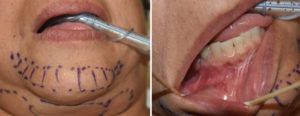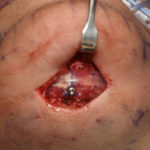Background: The most common facial augmentation procedure is the chin implant. It has been done for over fifty years with the silicone implant as the most common device used for most of this time. It is often combined with a rhinoplasty but can also be done along or in conjunction with anti-aging procedures like a facelift or other face and jawline procedures like jaw angle implants.
Chin implant designs have evolved over the years with the standard style now used being an extended or anatomic shape. These longer wings that go back along the jawline from the central area of projection allow a smoother transition into the jawline without an obvious ‘bump’ sitting on the chin. This creates a more natural chin augmentation result.
But these extended wings on a chin implant have some potential disadvantages as well. They require a longer dissection along the jawline for the wings to fit. And great attention has to be paid to their symmetrical pocket development and placement. A slight degree of tilt to the implant can have the back end of the wings more significantly displaced up or down. In fact the number one complication of such chin implants today is wing asymmetry.



Many chin implant revision cases s are due to an asymmetry caused by a tilt of the implant (yaw) or a side to side shift. While the best way to prevent this from occurring is to secure it firmly when initially placed, this becomes doubly important when repositioning the implant during a chin implant revision.
Highlights:
1) Extended style chin implants can develop asymmetry by malposition of their long wings.
2) Repositioning an asymmetric chin implant (chin implant revision) is best stabilized by screw fixation in its new position to prevent relapse.
3) The extended chin implant can have its wings shortened if that is aesthetically advantageous at the time of repositioning.
Dr. Barry Eppley
Indianapolis, Indiana


